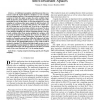Free Online Productivity Tools
i2Speak
i2Symbol
i2OCR
iTex2Img
iWeb2Print
iWeb2Shot
i2Type
iPdf2Split
iPdf2Merge
i2Bopomofo
i2Arabic
i2Style
i2Image
i2PDF
iLatex2Rtf
Sci2ools
CORR
2008
Springer
2008
Springer
Compressed Sensing of Analog Signals
Abstract--A traditional assumption underlying most data converters is that the signal should be sampled at a rate exceeding twice the highest frequency. This statement is based on a worst-case scenario in which the signal occupies the entire available bandwidth. In practice, many signals are sparse so that only part of the bandwidth is used. In this paper, we develop methods for low-rate sampling of continuous-time sparse signals in shift-invariant (SI) spaces, generated by kernels with period . We model sparsity by treating the case in which only out of the generators are active, however, we do not know which are chosen. We show how to sample such signals at a rate much lower than , which is the minimal sampling rate without exploiting sparsity. Our approach combines ideas from analog sampling in a subspace with a recently developed block diagram that converts an infinite set of sparse equations to a finite counterpart. Using these two components we formulate our problem within the fr...
| Added | 25 Jan 2011 |
| Updated | 25 Jan 2011 |
| Type | Journal |
| Year | 2008 |
| Where | CORR |
| Authors | Yonina C. Eldar |
Comments (0)

